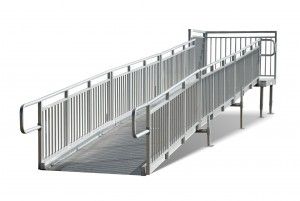There are more aluminum wheelchair ramp manufacturers than you might think, but if you want to go with the best, go with REDD Team. We’ve been designing and manufacturing ramps for more than 25 years, and we’re passionate about providing the very best customer service possible. Whether you need a ramp for a school building, a retail establishment, or just about anything else you can imagine, you should always turn to us first.
Why REDD Team?
 REDD Team has provided accessibility system components, such as ramps, stairs and many others, to a wide range of clients. These include commercial companies, military installations, construction sites, industrial sites, and many others. All of our products are versatile, rugged and affordable, and comply with all local, state and federal accessibility mandates.
REDD Team has provided accessibility system components, such as ramps, stairs and many others, to a wide range of clients. These include commercial companies, military installations, construction sites, industrial sites, and many others. All of our products are versatile, rugged and affordable, and comply with all local, state and federal accessibility mandates.
The best-known accessibility law is the Americans with Disabilities Act (ADA), which the U.S. Congress passed in 1990. Designed to make it possible for all people – regardless of their physical challenges – to access public facilities, the ADA can be very complex. At the same time, however, failure to comply with the Act can have harsh consequences, including fines and the possibility of lawsuits.
At REDD Team, however, we’re experts in the ADA and all other accessibility requirements. We know the ADA in and out, so you don’t have to. As important as it is to comply with the ADA, however, city and county governments can often impose even more restrictions. You need to make sure you speak with your local building code authorities to make sure your ramps comply with all accessibility regulations.
ADA Wheelchair Ramp Requirements
Again, ADA requirements can be very difficult to totally understand, much less put into action. But we’ll take that burden off of your shoulders. These are just some of the ADA regulations that pertain to wheelchair ramps alone.
- Landings – Wheelchair ramps must feature level landings at both the bottom and the top. They have to be as wide as the widest portion of the ramp, and must run for at least five feet (60 inches). If your ramp changes direction in areas, it must have a five-foot minimum landing where those direction changes take place. If you plan to install your ramp in an area that tends to get wet, it must be designed in a way that resists water accumulation. Our aluminum ramps fit the bill perfectly, because they’re naturally water resistant.
- Handrails – If the ramp rises more than six inches off of the ground, handrails must be included on both sides. These rails have to rise at least 34-38 inches off of the ground, and have to extend at least a foot from the end of the ramp to reduce the risk of slipping. Not only do our ramps include handrails that fit those requirements, our rails are also safe to touch regardless of the outside temperature.
- Other requirements – Ramps must have a slope-to-height ratio of no more than 1-to-12, meaning it can’t slope more than one inch high for every foot of length. The maximum amount of rise allowed is 30 inches, except in certain types of work areas. This is another area where we can make sure your ramps are ADA-compliant.
Get in touch with REDD Team to learn what separates us from other aluminum wheelchair ramp manufacturers. Contact us online or call 800-648-3696.
